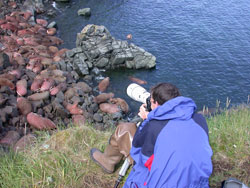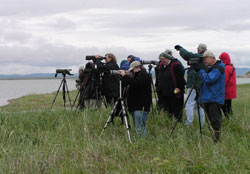Tips and Safety
Wildlife Viewing
 It's happened to all of us. You're walking down a trail and there, out of the corner of your eye, is a brief flash of color, the
tip of a tail disappearing, a scurried movement plunging deeper into the brush. The truth is, animals often see, hear, and smell
us long before we have any idea they're present. If you hone your senses, however, and learn how to pick out animal signs from your
surroundings, you'll stand a better chance of seeing more than just a flash of movement. We've compiled a few hints in this section
under spotting wildlife.
It's happened to all of us. You're walking down a trail and there, out of the corner of your eye, is a brief flash of color, the
tip of a tail disappearing, a scurried movement plunging deeper into the brush. The truth is, animals often see, hear, and smell
us long before we have any idea they're present. If you hone your senses, however, and learn how to pick out animal signs from your
surroundings, you'll stand a better chance of seeing more than just a flash of movement. We've compiled a few hints in this section
under spotting wildlife.
Say you're on a trail and you're not sure why a sparrow keeps "chipping" at you repeatedly, why a moose blocking the path just won't move, or why that deer has its big ears trained like radar. Under signs of alarm, we explain how different species signal their unease and how disturbances may affect their well-being.
 Do you have the right tools with you? A good pair of shoes is always a sure bet, but check our
photography page for some basics on getting a good picture or
using binoculars for a sharp close-up view. Are you ready for the challenge of Alaska's
weather and terrain, especially when off the beaten path? Take a look at our remote travel tips
before you go.
Do you have the right tools with you? A good pair of shoes is always a sure bet, but check our
photography page for some basics on getting a good picture or
using binoculars for a sharp close-up view. Are you ready for the challenge of Alaska's
weather and terrain, especially when off the beaten path? Take a look at our remote travel tips
before you go.
Finally, please take the time to review our viewing ethics. Even those of us with the best of intentions can lose sight of how our actions might be affecting wildlife, its habitat, and other viewers. It's a tremendous privilege to observe wild animals in their natural environment. Treat that privilege responsibly.
